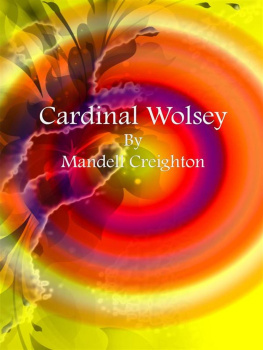Copyright 1968, 2004 Helen Creighton
All rights reserved. No part of this book may be reproduced, stored in a retrieval system or transmitted in any form or by any means without the prior written permission from the publisher, or, in the case of photocopying or other reprographic copying, permission from Access Copyright, 1 Yonge Street, Suite 1900, Toronto, Ontario M5E 1E5.
Nimbus Publishing Limited
PO Box 9166
Halifax, NS B3K 5M8
(902) 455-4286
NB0605
Printed and bound in Canada
Cover design: Min Landry, Wink Design
Interior design: Terri Strickland
Library and Archives of Canada Cataloguing in Publication
Bluenose magic : popular beliefs and superstitions in Nova Scotia
/ edited by Helen Creighton ; with a new foreword by Clary Croft.
Reprint of: 2004.
Electronic monograph in HTML format.
ISBN 978-1-77108-260-0 (html)
1. Folklore--Nova Scotia. 2. Nova Scotia--Social life and customs.
I. Creighton, Helen, 1899-1989, editor II. Croft, Clary, writer of supplementary textual content
GR113.5.N69B58 2004 398.2'09716 C2004-902438-8
Nimbus Publishing acknowledges the financial support for its publishing activities from the Government of Canada through the Canada Book Fund (CBF) and the Canada Council for the Arts, and from the Province of Nova Scotia through Film & Creative Industries Nova Scotia. We are pleased to work in partnership with Film & Creative Industries Nova Scotia to develop and promote our creative industries for the benefit of all Nova Scotians.
Foreword
In Nova Scotia, with its myriad traditional and recently introduced cultures, we find a variety of beliefs and superstitions perhaps unparalleled in Canada. The material in this book, collected between 1928 and 1967, represents, almost exclusively, six main traditional cultural groups in Nova Scotia: Mikmaw, French, African Nova Scotian, English, Celtic, and German (Foreign Protestant).
The study of folklore is one way of allowing us to see ourselves as part of a larger picture. Our traditions and beliefs come from our heritage, social interaction, and appropriated customs and concepts. In Bluenose Magic: Popular Beliefs and Superstitions in Nova Scotia, Helen Creighton allows us to see ourselves as a part of a bigger worlda world sometimes very different from our own.
Depending on your personal background and interest in folklore, the beliefs and superstitions Helen writes about in this book may seem familiar, archaic, or even quaint. We may laugh or scoff at some of these so-called quaint superstitions and folk remediesthat is, until we see one of our own among them, and all of a sudden we recognize something of ourselves.
Readers shouldnt see this collection as a body of beliefs once held by the general population of Nova Scotia. Even during the years Helen was collecting this material, those sharing their stories with her (the informants or tradition-bearers) frequently felt that the information was of another time. I say frequently, but not always. There were times when a tradition-bearer told Helen a personal supernatural experience because they saw her as an empathetic listener. As Helens exploration of the supernatural grew, she felt more comfortable identifying and speaking about what she felt were supernatural experiences in her own life.
This book is a disparate collection of folk beliefs and superstitions. It differs from Helens other important collection of beliefs and folklore, Folklore of Lunenburg County, Nova Scotia, in that the monograph on Lunenburg County folklore is a concentrated study of a particular area, while the material in this book represents the sweep and cull technique of collecting folklore. This latter, broad style is often criticized by todays folklorists, and received similar criticism when Bluenose Magic debuted in 1968. Norwegian folk scholar Otto Blehr, in a review of Bluenose Magic for the Journal of American Folklore, writes, folklorists are led to ignore the fact that such dictionary-collections are useless in explaining the form of folk belief communications take and the cultural and social functions of these communications. In Helens defenseshe never claimed to be a folklore analyst. She always maintained she was a collector and left the analysis up to the scholars. In the scholars defensethey could do more with the material if Helen had provided additional background. Even during the writing of Bluenose Magic, Helen was at odds with her museum colleagues whose own opinions differed with those of Helens contemporaries in the field of folklore.
When Wayland Debs Hand (190786) put out the call for folklorists to compile individual regional collections as part of a huge international corpus of popular beliefs and superstitions, the notice carried in the The Northeast Folklore Society Newsletter #3 in 1963 told the collectors to canvass their region and publish tributary volumesstart with yourself; you are your best informant. However, Helens boss at the National Museum of Canada, Carmen Roy, was adamant that Helen not include her personal beliefs. Helens reply was that of a fighter: Here now we come to what I consider one of the most important features of this book. I am not writing of them, the People from Nova Scotia, but US, We People of Nova Scotia, and I think Wayland must have had this in mind when he extended his invitation. After all, I am 6th generation on both sides of my family, and the beliefs I give as my own are not made up by me, but are part of my inheritance as a native of this province. This, I feel, takes this out of the realm of being just another compilation of beliefs and superstitions, but part of life shared by the collector. Why can I not serve the dual role of collector and informant when I have so much to offer? And why should my traditional beliefs not have their place as well as those of any other inhabitant? They cannot possible distract from the books scholarship and they certainly add to its authenticity and worth. That, at least, is my impression. Otherwise anybody could write the book providing they had a file of index cards. Take that away and you remove the soul.
Helen also had Wayland Hand on her side. In 1966, he wrote to her with his opinions on the inclusion of her own family folk beliefs: The personal touch seems also to make the material more intimate and believable, in the sense that the author herself knows of these matters and has believed, or half-way believed them. Helen, as was often her wont, got her way. Her own familys traditional beliefs do appear in this book, listed most often as Dartmouth, English.
But Bluenose Magic is much more than a collection of superstitions and beliefs. If you read between the lines youll find common joys and fears, collective memories, invaluable oral history, and a sense of the magical world of truth tempered with imaginationall told, where possible, in the words of the tradition-bearers themselves. Helen was an amazing record keeper. During my tenure as archivist for Helens collection, I checked many of the items in this book against the original tape recordings housed in the Helen Creighton Fonds at the Nova Scotia Archives and Record Management. Helen has taken the voices of the tradition bearers and put them on the page.
As you read through Bluenose Magic you may wish for more analytical theory from the author; you may lament gaps (as Helen herself did in her original introduction); or you may have no interest in the substantial footnotes Helen put at the end of each chapter for the benefit of scholars. But you cant read this book and not be drawn into the time and lifestyle that she captures. To be sure, a new contemporary form of folk belief is alive. Where Helen collected lore concerning phantom ships and folk remedies for oxen, todays folklore collectors are exploring UFO lore and urban myths. In Bluenose Magic you will find voices from the pasta past strangely familiar, yet tinged withwhat else? Magic!






